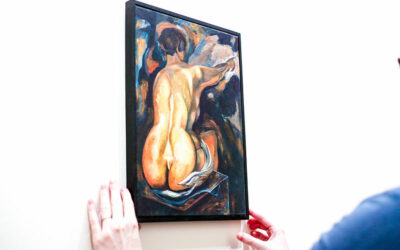Have you ever ruined a painting that you liked because you did not know that there are rules to follow to ensure good conservation of the paintings?
I have ruined more than one work. Last month coming into my studio I had an unpleasant surprise: a couple of pictures had been bent because they were placed one on top of the other without any separation between them.
This experience led me to do some research to understand how to fix it, if possible, and above all to avoid continuing making mistakes.
In this article I want to share with you what I have discovered so that you can preserve your masterpieces in the best way.
There are some simple tips that I shared on my Instagram post.
Tricks to preserve your works
Pay attention to your hands
- Avoid touching your paintings directly without wearing cotton gloves. If you do so, you risk damaging them with exposure to your fingerprints and natural oils.
- Do not hang your artwork near direct sunlight. If you are an artist and have a large production of paintings, cover them with an acid-free cloth.
- Watch out for moisture. Always check the humidity level in your home or studio: the ideal is to have it around 55% (use a hygrometer).
- The rules of the pantry also apply to paintings: keep them in a cool, dry and dark place.
- Avoid using cleaners or solvents. Dust your paints with a soft cloth or brush.

Do not place the paintings one on top of each other.
The weight and the difference in measurements could damage them. Place a rag or cardboard between each work; this will protect the painting from acids and possible wrinkles. When overlapping them, be careful that they are not in direct contact.
Remember that the paper works that you need to send or that you have not yet framed should be covered with a sheet of paper, rolled up and stored in shipping tubes. Or if you keep them at home, but they are not exposed, store them in a dry drawer, covered with paper and away from direct light.
How to repair damaged paintings?
What do we do with canvases that have been marked after being placed under an object? There is a trick: wet a brush with water (little water) and go little by little the area of ”crease” behind the canvas. Once dry, the canvas should be smooth again.
Grandma’s remedies are not valid to clean paintings. They include the use of raw potatoes, milk or onions, but I have tried them all and I have had an unpleasant surprise: the residues of these products are deposited on the paint and afterwards I have not been able to remove them from the painted surface.
However, I was surprised to find that there is a maintenance technique that involves applying a very thin layer of saliva to the canvas with a brush. This method has even been promoted by some restorers, such as Helmut Ruhemann and Paul Frederick.
Remember that paintings made with charcoal, pencil, traditional oil or wax pastels, watercolors and works on paper cannot be cleaned by directly working on the surface.
For old paintings it is better to turn to professional restorers!
Sources:
parkwestgallery.com; lifestorage.com




0 Comments